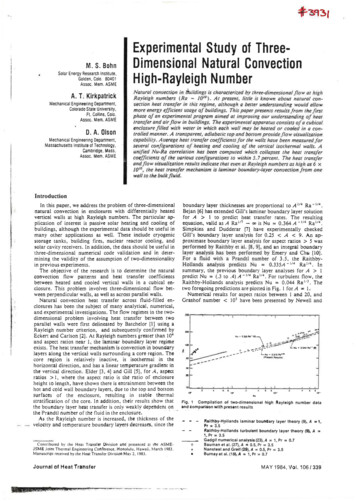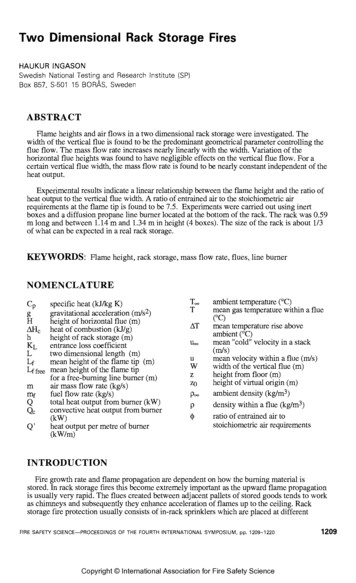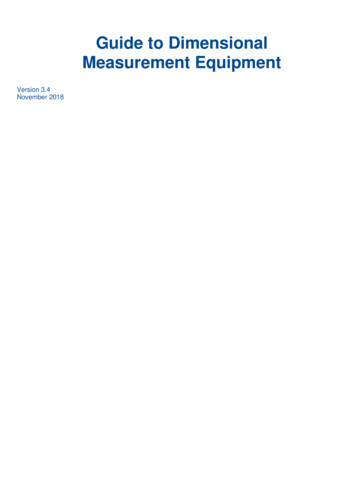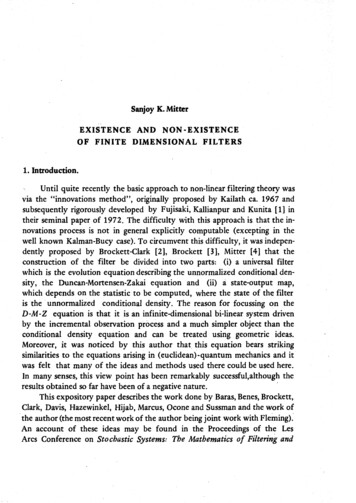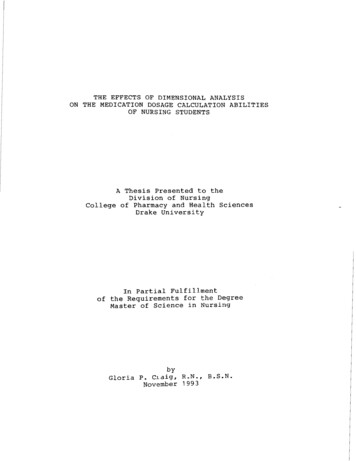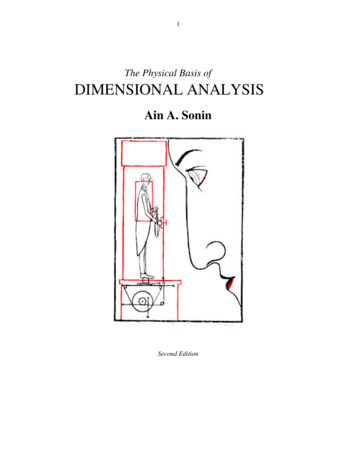
Transcription
1The Physical Basis ofDIMENSIONAL ANALYSISAin A. SoninSecond Edition
2Copyright 2001 by Ain A. SoninDepartment of Mechanical EngineeringMITCambridge, MA 02139First Edition published 1997. Versions of this material have been distributed in 2.25Advanced Fluid Mechanics and other courses at MIT since 1992.Cover picture by Pat Keck (Untitled, 1992)
3Contents1. Introduction12. Physical Quantities and Equations42.1 Physical properties2.2 Physical quantities and base quantities2.3 Unit and numerical value2.4 Derived quantities, dimension, and dimensionless quantities2.5 Physical equations, dimensional homogeneity, andphysical constants2.6 Derived quantities of the second kind2.7 Systems of units2.8 Recapitulation3. Dimensional Analysis45101215192227293.1 The steps of dimensional analysis and Buckingham’sPi-Theorem29Step 1: The independent variablesStep 2: Dimensional considerationsStep 3: Dimensional variablesStep 4: The end game and Buckingham’s Π-theorem293032323.2 Example: Deformation of an elastic sphere striking a wall 33Step 1: The independent variablesStep 2: Dimensional considerationsStep 3: Dimensionless similarity parametersStep 4: The end game3.2 On the utility of dimensional analysis and some difficultiesand questions that arise in its applicationSimilarityOut-of-scale modelingDimensional analysis reduces the number of variablesand minimizes work.3335363737373838
4An incomplete set of independent quantities maydestroy the analysisSuperfluous independent quantities complicate the resultunnecessarilyOn the importance of simplifying assumptionsOn choosing a complete set of independent variablesThe result is independent of how one chooses a dimensionallyindependent subsetThe result is independent of the type of system of units4040414243434. Dimensional Analysis in Problems Where Some IndependentQuantities Have Fixed Values45Cited References49Other Selected References51AcknowledgementsMy thanks to Mark Bathe, who volunteered to perform thecomputation for the elastic ball. This work was begun withsupport from the Gordon Fund.
5Francis Bacon (1561-1628)1:“I found that I was fitted for nothing so well as the study ofTruth; as having a nimble mind and versatile enough tocatch the resemblance of things (which is the chief point),and at the same time steady enough to fix and distinguishtheir subtle differences.”“Think things, not words.”Albert Einstein (1879-1955)2:“ all knowledge starts from experience and ends in it.Propositions arrived at by purely logical means arecompletely empty as regards reality."Percy W. Bridgman (1882-1961)3:“.what a man means by a term is to be found by observingwhat he does with it, not by what he says about it.”1Catherine Drinker Bowen, 19632 Einstein, 19333 Bridgman, 1950
61. IntroductionDimensional analysis offers a method for reducing complex physicalproblems to the simplest (that is, most economical) form prior to obtaininga quantitative answer. Bridgman (1969) explains it thus: "The principaluse of dimensional analysis is to deduce from a study of the dimensions ofthe variables in any physical system certain limitations on the form of anypossible relationship between those variables. The method is of greatgenerality and mathematical simplicity".At the heart of dimensional analysis is the concept of similarity. Inphysical terms, similarity refers to some equivalence between two thingsor phenomena that are actually different. For example, under some veryparticular conditions there is a direct relationship between the forcesacting on a full-size aircraft and those on a small-scale model of it. Thequestion is, what are those conditions, and what is the relationshipbetween the forces? Mathematically, similarity refers to a transformationof variables that leads to a reduction in the number of independentvariables that specify the problem. Here the question is, what kind oftransformation works? Dimensional analysis addresses both thesequestions. Its main utility derives from its ability to contract, or makemore succinct, the functional form of physical relationships. A problemthat at first looks formidable may sometimes be solved with little effortafter dimensional analysis.In problems so well understood that one can write down inmathematical form all the governing laws and boundary conditions, andonly the solution is lacking, similarity can also be inferred by normalizingall the equations and boundary conditions in terms of quantities thatspecify the problem and identifying the dimensionless groups that appearin the resulting dimensionless equations. This is an inspectional form ofsimilarity analysis. Since inspectional analysis can take advantage of theproblem's full mathematical specification, it may reveal a higher degree ofsimilarity than a “blind” (less informed) dimensional analysis and in thatsense prove more powerful. Dimensional analysis is, however, the onlyoption in problems where the equations and boundary conditions are notcompletely articulated, and always useful because it is simple to apply andquick to give insight.Some of the basic ideas of similarity and dimensional analysis hadalready surfaced in Fourier's work in the nineteenth century's first quarter,
7but the subject received more methodical attention only toward the closeof that century, notably in the works of Lord Rayleigh, Reynolds,Maxwell, and Froude in England, and Carvallo, Vaschy and a number ofother scientists and engineers in France (Macagno, 1971)4. By the 1920'sthe principles were essentially in place: Buckingham's now ubiquitousπ theorem had appeared (Buckingham, 1914), and Bridgman hadpublished the monograph which still remains the classic in the field(Bridgman, 1922, 1931). Since then, the literature has grown prodigiously.Applications now include aerodynamics, hydraulics, ship design,propulsion, heat and mass transfer, combustion, mechanics of elastic andplastic structures, fluid-structure interactions, electromagnetic theory,radiation, astrophysics, underwater and underground explosions, nuclearblasts, impact dynamics, and chemical reactions and processing (see forexample Sedov, 1959, Baker et al, 1973, Kurth, 1972, Lokarnik, 1991),and also biology (McMahon & Bonner, 1983) and even economics (deJong, 1967).Most applications of dimensional analysis are not in question, nodoubt because they are well supported by experimental facts. The debateover the method's theoretical-philosophical underpinnings, on the otherhand, has never quite stopped festering (e.g. Palacios, 1964).Mathematicians tend to find in the basic arguments a lack of rigor and aretempted to redefine the subject in their own terms (e.g. Brand, 1957),while physicists and engineers often find themselves uncertain about thephysical meanings of the words in terms of which the analysis cast. Theproblem is that dimensional analysis is based on ideas that originate atsuch a substratal point in science that most scientists and engineers havelost touch with them. To understand its principles, we must return to someof the very fundamental concepts in science.Dimensional analysis is rooted in the nature of the artifices weconstruct in order to describe the physical world and explain itsfunctioning in quantitative terms. Einstein (1933) has said, "Pure logicalthinking cannot yield us any knowledge of the empirical world; allknowledge starts from experience and ends in it. Propositions arrived at bypurely logical means are completely empty as regards reality."4See, for example, the very first page of the first volume of James Clerk Maxwell’s Atreatise on Electricity and Magnetism (third edition, Clarendon Press, Cambridge, 1891;republished by Dover, New York, 1954)
8This treatise is an attempt to explain dimensional analysis by tracing itback to its physical foundations. We will clarify the terms used indimensional analysis, explain why and how it works, remark on its utility,and discuss some of the difficulties and questions that typically arise in itsapplication. One single (unremarkable) application in mechanics will beused to illustrate the procedure and its pitfalls. The procedure is the samein all applications, a great variety of which may be found in the referencesand in the scientific literature at large.
92. Physical Quantities and Equations2.1 Physical propertiesScience begins with the observation and precise description of things andevents. It is at this very first step that we face the fact upon whichdimensional analysis rests: Description in absolute terms is impossible.We can do no more than compare one thing with another, to "catch theresemblance of things". When we say that something "is" a tree, we meansimply that it has a set of attributes that are in some way shared by certainfamiliar objects we have agreed to call trees.Our brains have evolved to the point where we can recognize treesalmost instantly, but describing something like a tree is actually a verycomplex business. Physics starts by breaking the descriptive process downinto simpler terms. An object or event is described in terms of basicproperties like length, mass, color, shape, speed, and time. None of theseproperties can be defined in absolute terms, but only by reference tosomething else: an object has the length of a meter stick, we say, the colorof an orange, the weight of a certain familiar lump of material, or theshape of a sphere. The references may be made more precise, but inessence "description" is simply a noting of the similarities between onething and a set of others that are known to us. We can do no more thancompare one thing with another.A physical property first arises as a concept based on experience, andis formalized by defining a comparison operation for determining whethertwo samples of it are equal (A B) or unequal (A B). (We shall use boldsymbols when we are referring not to numerical values, but to actualphysical attributes.) This operation, which is an entirely physicalprocedure, defines the property. Properties of the same kind (or simply, thesame properties) are compared by means of the same comparisonoperation. Properties of different kinds cannot be compared because thereexists no operation that defines equality. Asking whether a particular massis physically equal to a particular length is meaningless: no procedureexists for making the comparison.If a property is defined only in terms of a comparison operation, wehave a procedure for establishing whether two samples of it are equal orunequal, but no concept of what it means for one to be larger or smallerthan the other. Shape and color are examples. We have procedures for
10determining if two objects have the same shape, or the same color. Butasking whether a square shape is smaller or larger than a circular shape, orwhether green is smaller or larger than white, makes no sense. Propertieslike shape and color are useful for describing things, but cannot play a rolein any quantitative analysis, which deals with relative magnitudes.2.2 Physical quantities and base quantitiesScience begins with observation and description, but its ultimate goal is toinfer from those observations laws that express the phenomena of thephysical world in the simplest and most general (that is, most economical)terms. That the language of mathematics is ideally suited for expressingthose laws is not accidental, but follows from the constraints we put on thetypes of physical properties that are allowed to appear in quantitativeanalysis. The allowed types of properties are called "physical quantities".Physical quantities are of two types: base quantities and derivedquantities. The base quantities, which are defined in entirely physicalterms, form a complete set of basic building blocks for an open-endedsystem of “derived” quantities that may be introduced as necessary. Thebase and derived quantities together provide a rational basis for describingand analyzing the physical world in quantitative terms.A base quantity is defined by specifying two physical operations:a comparison operation for determining whether two samples Aand B of the property are equal (A B) or unequal (A B), andan addition operation that defines what is meant by the sumC A B of two samples of the property.Base quantities with the same comparison and addition operations are ofthe same kind (that is, different examples of the same quantity). Theaddition operation A B defines a physical quantity C of the same kind asthe quantities being added. Quantities with different comparison andaddition operations cannot be compared or added; no procedures exist forexecuting such operations. All physical quantities are properties ofphysical things or events. They are not themselves physical things orevents. The comparison and addition operations involve physical
11manipulations of objects or events that possess the property underconsideration (see the examples below).The comparison and addition operations are physical, but they arerequired to have certain properties that mimic those of the correspondingmathematical operations for pure numbers:(1) The comparison operation must obey the identity law (if A B andB C, then A C), and(2) the addition operation must be commutative (A B B A), associative[A (B C) (A B) C], and unique (if A B C, there exists no finiteD such that A B D C).The two operations together define, in entirely physical terms,(1) the concept of larger and smaller for like quantities (if there exists afinite B such that A B C, then C A),(2) subtraction of like quantities (if A B C, then A C-B),(3) multiplication of a physical quantity by a pure number (if B A A A,then B 3A), and(4) division of a physical quantity by a pure number (if A B B B, thenB A/3).A base quantity is thus a property for which the following mathematicaloperations are defined in physical terms: comparison, addition,subtraction, multiplication by a pure number, and division by a purenumber. Each of these operations is performed on physical properties ofthe same kind and yields a physical property of that kind, and eachphysical operation obeys the same rules as the correspondingmathematical operation for pure numbers.This sets the stage for not only "catching the resemblance of things",but also expressing that resemblance in the language of mathematics.It is important to note that mathematical operations other than the oneslisted above are not defined in physical terms. No defining operation existsfor forming a tangible entity that represents the product of a mass and atime, for example, or, for that matter, the product of one length andanother (more on this later). Nor can we point to some tangible thing that"is" the cube root of a length, say, or the natural logarithm of a time.Products, ratios, powers, and exponential and other functions such as
12trigonometric functions and logarithms are defined for numbers, but haveno physical correspondence in operations involving actual physicalquantities.Figure 2.1 illustrates the comparison and addition operations of somewell-known physical quantities that can be chosen as base quantities. Thefigure shows them in simplistic, cartoon-like terms, but we are of courseaware that each operation is actually associated with a carefully articulatedprocedure and a set of concepts that are often quite complex. For ourpresent purpose we take these for granted, much like Dr. Samuel Johnsonwho, when queried about how he knew that the physical world reallyexisted, satisfied himself by stamping his foot on the pavement.Figure 2.1a: The comparison and addition operations of length.Figure 2.1b: The comparison and addition operations of mass.
13Figure 2.1c: The comparison and addition operations of area.Figure 2.1d: The comparison and addition operations of velocity.Figure 2.1e: The comparison and addition operations of force.The comparison and addition operations for length and mass arefamiliar. Only one comment is necessary: the mass referred to in the figureis the "gravitational mass”, for which equality is defined by the statement
14that two masses are equal if a third mass exerts the same gravitationalforce on each of them separately at the same relative position.Time is omitted from the figure, largely because its definingoperations defy illustration in such simplistic terms. The concept of time isdeeply rooted in our biological beings. It is, after all, the warp of ourexistence, the stuff, as some wit pointed out, that keeps everything fromhappening at once. Time characterizes an event, not a thing. Aristotlereferred to time as a "dimension of motion", which pleases the poet in us,but leaves the scientist unmoved. We do best if we adopt a pragmaticnotion of time and think of it as being defined in terms of comparison andaddition operations involving idealized clocks or stopwatches, much likeEinstein did in his popular exposition of the theory of relativity (Einstein,1952). Whether those clocks are hourglasses or atomic clocks will affectthe precision of the operations, but not their intrinsic character. What time"is" has no relevance in the present context, only the defining operationsmatter5.The concept of force arises in primitive terms from muscular effort,and is formalized based on the observation that a net force on an object(the vector sum of all the forces acting on the object) causes a rate ofchange in its velocity. Directionality is important in the definition: force isa vector quantity.A reader accustomed to considering speed as "distance divided bytime" and area as "length squared" may be surprised to see them includedin figure 2.1 as (possible) base quantities with their own comparison andaddition operations. We include them to show that the set of basequantities is very much a matter of choice. Velocity (or speed, if directionis presumed) is a certain property of motion. A self-propelled toy carrunning across a tabletop has a speed, and we can define acceptableprocedures for establishing whether two speeds are equal or unequal andfor adding two speeds, as in figure 2.1d. Speed can therefore be taken as abase quantity, should we choose to do so. The same goes for area. Notethat two areas may be equal without being congruent, provided one of5Sir Arthur Eddinton (1939): "It has come to be accepted practice in introducing newphysical quantities that they shall be regarded as defined by the series of measuringoperations and calculations of which they are the result. Those who associate with theresult a mental picture of some entity disporting itself in a metaphysical realm ofexistence do so at their own risk; physics can accept no responsibility for thisembellishment".
15them can be "cut up" and reassembled (added back together) into a formwhich is congruent with the other: the addition operation is invoked inmaking a comparison, and the comparison operation in addition.We have said that shape and color, though acceptable physicalproperties, cannot be base quantities because they lack acceptable additionoperations. That shape is disqualified is obvious: what is the sum of asquare and a circle? But why is color disqualified? We know that color inthe form of light can be added according to well-defined rules, as whenred light added to green produces yellow. Is this not an acceptabledefinition of physical addition? The answer is no. Blue equals blue. Butaccording to this addition operation, blue plus blue also equals blue. Theaddition operation is not unique: nA A for any color A, where n is anynumber. This disqualifies color from the ranks of physical quantities (andmakes measurement of color in terms of a unit impossible). But, thepersistent reader may argue, the color of an object can be identified by thewavelength of light reflected from it, and wavelength can be added. Is thisnot acceptable for an addition rule? The answer is again no. This is a rulefor adding lengths, not for adding the property we perceive as color.2.3 Unit and numerical valueThe two operations that define a base quantity make it possible toexpress any such quantity as a multiple of a standard sample of its ownkind, that is, to "measure it in terms of a unit". The standard sample—theunit—may be chosen arbitrarily. The comparison operation allows thereplication of the unit, and the addition operation allows the identificationand replication of fractions of the unit. The measuring process consists ofphysically adding replicas of the unit and fractions thereof until the sumequals the quantity being measured (figure 2.2). A count of the numberof whole and fractional units required yields the numerical value ofthe quantity being measured. If a is the unit chosen for quantities of typeA, the process of measurement yields a numerical value A (a number)such thatA Aa(2.1)The measurement process is entirely physical. The only mathematicsinvolved is the counting of the number of whole and fractional units once
16physical equality has been established between the quantity beingmeasured and a sum of replicas of the unit and fractions thereof.Figure 2.2: Measurement in terms of a unit and numerical valueIt should be emphasized that numbers can be ascribed to properties inmany arbitrary ways, but such numbers will not represent numericalvalues of physical quantities unless they are assigned by a procedureconsistent with the one defined above.The numerical value of a base quantity depends on the choice of unit.A physical quantity exists, independent of the choice of unit. Myforefinger has the same length, regardless of whether I measure it incentimeters or inches. A quantity A can be measured in terms of a unit a orin terms of another unit a', but the quantity itself remains physically thesame, that is,A Aa A'a'.(2.2)If the unit a' is n times larger than a,a' na,(2.3)it follows from equation (2.2) thatA ′ n 1 A .(2.4)If the size of a base quantity's unit is changed by a factor n, the quantity'snumerical value changes by a factor n-1.By convention, all base quantities of the same kind are alwaysmeasured in terms of the same unit. All base quantities of the same kind
17thus change by the same factor when the size of that quantity's unit ischanged. That is, the ratio of the numerical values of any two quantities ofthe same kind is independent of base unit size.Note also that when base quantities of the same kind are addedphysically (A B C), the numerical values satisfy an equation of the sameform as the physical quantity equation (A B C), regardless of the size ofthe chosen unit. In other words, the numerical value equation mimics thephysical equation, and its form is independent of the unit’s size.2.4 Derived quantities, dimensions, and dimensionless quantitiesIn describing physical things and events quantitatively, we refer tonumerical values of base quantities, and also introduce numbers derivedby inserting these values into certain mathematical formulas. Wedetermine the distance L that an object moves in time t, for example, andcalculate its speed V Lt-1; or we measure a body's mass m and speed V andcalculate its kinetic energy K mV2/2. These numbers are derivedquantities of the first kind.Not all numbers obtained by inserting base quantities into formulascan be considered physical quantities6. Base quantities have atransparently physical origin, which gives rise to the fact that the ratio ofany two samples of a base quantity remains constant when the base unitsize is changed; an arbitrary choice cannot affect a relative physicalmagnitude. Bridgman (1931) postulated that this is in fact a definingattribute of all physical quantities. This isBridgman’s principle of absolute significance of relative magnitude:A number Q obtained by inserting the numerical values of basequantities into a formula is a physical quantity if the ratio of anytwo samples of it remains constant when base unit sizes arechanged.Bridgman went on to show (Bridgman, 1931; see also the proof byBarenblatt, 1996) that a monomial formula satisfies the principle of6From this point on, the term quantity will be used for the numerical value of a physicalquantity, unless otherwise noted.
18absolute significance of relative magnitude only if it has the power-lawformQ A a B b C c .(2.5)where A, B, C, etc. are numerical values of base quantities and thecoefficient and exponents a, b, c, etc. are real numbers whose valuesdistinguish one type of derived quantity from another. All monomialderived quantities have this power-law form; no other form represents aphysical quantity.A derived quantity of the first kind is defined in terms of a numericalvalue, which depends on the choice of base units. A derived quantity doesnot necessarily represent something tangible in the same sense as a basequantity, although it may. The square root of time, for example, is aderived quantity because it has the required power-law form, but wecannot point to any physical thing that “is” the square root of time.To avoid talking of "units" for quantities that may have no physicalrepresentation, but whose numerical values nevertheless depend on thechoice of base units, we introduce the concept of dimension. Each type ofbase quantity has by definition its own dimension. If A is the numericalvalue of a length, we say it “has the dimension of length”, and write this as[A] L where the square brackets imply “the dimension of” and Lsymbolizes the concept of length. By this we mean simply that if thelength unit size is increased by a factor n, the numerical value A willincrease by a factor n-1.The dimension of a derived quantity conveys the same information ingeneralized form, for derived as well as base quantities. Consider aquantity defined by the formulaQ Ll11 Ll22 .M1m1 M2m2 .t1 1 t2 2 .(2.6)where the Li's are numerical values of certain lengths, Mi's of certainmasses, and ti's of certain times, and and all exponents are real numbers.If the length unit is changed by a factor nL , the mass unit by a factor nm ,and the time unit by a factor nt , it follows from equations (2.4) and (2.6)that the value of Q changes toQ′ n 1Q(2.7a)
19wheren (n L ) li(n m ) mi ( nt ) ti .(2.7b)This implies that Q transforms like the numerical value of a base quantitywith a unit whose size is proportional to L l i M mi t i , where L, M, and trepresent the sizes of the length, mass, and time units, respectively. Byanalogy with the meaning of dimension for base quantities [see equation(2.4)], we therefore say that the derived quantity Q has the dimension[Q] ( L) l i ( M ) mi ( t) ti .(2.8)Whether applied to a base or derived quantity, the dimension is simplya formulaic indication of how the quantity's numerical value transformswhen the sizes of the base units are changed. A derived quantity'sdimension follows from its defining equation. To obtain the result (2.8) forthe quantity defined in equation (2.6), we simply substitute for each basequantity in equation (2.6) the symbol for its dimension, omit the numericalcoefficient α, and obtain equation (2.8) by algebra. The dimension of akinetic energy mV 2 2, for example, is M(L t) 2 ML2 t 2 .Statements to the effect that a quantity’s dimension is an “expressionof its essential physical nature” (Tolman, 1917) are either a meaninglesstautology (in the case of base quantities) or nonsense (in the case ofderived quantities). We shall see that a quantity’s dimension depends onthe choice of the system of units, and is therefore under the control of theobserver rather than an inherent attribute of that quantity.By convention, a particular derived quantity is specified by itsnumerical value followed by the base units upon which that value is based,the latter arranged in a form which reflects the quantity's dimension. Thestatement Q 0.021kg s1/2 implies that Q is a quantity with dimension1 2Mt and has a magnitude 0.021 if mass is measured in kilograms andtime in seconds. Speaking loosely, it may be said that the quantity Q is"measured in units of kg s1/2", which implies both its dimension and thebase units on which the indicated value is based. In common parlance theterms unit and dimension are often used synonymously, but such usage isundesirable in a treatise where fundamental understanding is paramount.
20Some important points about derived quantities:1. The dimension of any derived physical quantity is a product ofpowers of the base quantity dimensions.2. Sums of derived quantities with the same dimension are derivedquantities of the same dimension. Products and ratios of derived quantitiesare also derived quantities, with dimensions which are usually differentfrom the original quantities.3. All derived quantities with the same dimension change their valuesby the same factor when the sizes of the base units are changed.4. A derived quantity is dimensionless if its numerical value remainsinvariant when the base units are changed. An example is Vt L , whereV dx dt is a velocity, t is a time and L is a length. The dimension of adimensionless quantity is unity, the factor by which the quantity'snumerical value changes when base units sizes are changed.5. Special functions (logarithmic, exponential, trigonometric, etc.) ofdimensional derived quantities are in general not derived quantitiesbecause their values do not in general transform like derived quantitieswhen base unit size changes. Only when the arguments of these functionsare dimensionless will the arguments and therefore the values of thefunctions remain invariant when units are changed. Special functions withdimensionless arguments are therefore derived quantities with dimensionunity.2.5 Physical equations, dimensional homogeneity, and physicalconstantsIn quantitative analysis of physical events one seeks mathematicalrelationships between the numerical values of the physical quantities thatdescribe the event. We are not, however, interested in just anyrelationships that may apply between the values of physical quantities. Aprimitive soul may find it
2.1 Physical properties Science begins with the observation and precise description of things and events. It is at this very first step that we face the fact upon which dimensional analysis rests: Description in absolute terms is impossible. We can do n

